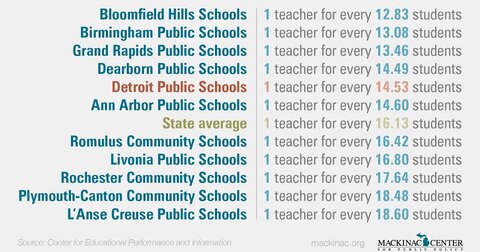State Data: No Detroit Teacher Shortage
Actual numbers don't support understaffing claims
For the last few years, stories about an alleged Detroit Public Schools teacher shortage have appeared in Michigan news outlets, implying that understaffing is due to low morale and poor working conditions, and has led to classroom overcrowding.
But data submitted by DPS to the state of Michigan show the district’s teacher-to-student ratio is lower than the state average and has been so for several years, with a lower teacher-to-student ratio than found in many more-affluent communities.
As of December 2015, DPS had one teacher for every 14.53 students, compared to the state average of one teacher for every 16.13 students. The figures come from the state of Michigan’s data clearinghouse and are based on information submitted by school districts.
Livonia Public Schools has one teacher for every 16.80 students and Plymouth-Canton Community Schools has one teacher for every 18.48 students. DPS states on its website that it has critical teacher shortages in some areas, in particular, specialized areas like foreign languages and special education.
Despite the actual numbers, the theme that DPS faces a teacher shortage has been promoted in news outlets going back to September 2014. While the district does have far fewer teachers than just a few years ago, the decline in that number is dwarfed by the drop in student enrollment. Put simply, there are fewer teachers because there are far fewer students.
According to the state’s Center for Educational Performance and Information, Detroit Public Schools had 4,754 full-time teaching positions in the 2012-13 school year. By December 2015, the number had fallen to 3,227.
However, in a May 18 email to Michigan Capitol Confidential, DPS reported the current figure to be 2,765 teachers. DPS hasn't responded to an email questioning the apparent discrepancy, but the district did say there were no midyear teacher layoffs this school year.
DPS had 5,163 full-time teacher positions in 2011-12, a number which fell to 3,227 in 2015-16. But the 37 percent drop in full-time teaching jobs doesn’t necessarily mean there is a teacher shortage; over those four years, enrollment plummeted from 70,326 in 2011-12 to 46,912 in 2015-16.
For several years, the ratio of DPS teachers to students has been much lower than the state average. In 2011-12, DPS had one teacher for every 13.62 students while the state average was one teacher for every 16.14 students.
When the media’s first teacher shortage stories appeared during the 2014-15 school year, DPS had one teacher for every 13.07 students. The state average that year was one teacher for every 15.94 students.
DPS may need more teachers per student than the state average. It has a higher proportion of students who are diagnosed with disabilities — 17.5 percent reported in 2015-16. That’s higher than the 12.3 percent countywide rate reported by a Wayne County educational service agency.
It is not unusual for urban districts to have higher levels of students who are diagnosed with disabilities. For example, Grand Rapids (22.5 percent), Flint (16.6 percent) and Saginaw (13.9 percent) all are above the state average of 12.8 percent.
The alleged teacher shortage has led to other claims that are not supported by the data. Media reports have claimed teacher shortages in the district led to overcrowded classes. However, DPS doesn’t have an overcrowding issue, according to data on classroom sizes it submitted in fall 2015-16 in response to a Freedom of Information Act request. The DPS classroom data showed the district has smaller class sizes than many neighboring communities.
Michigan Capitol Confidential is the news source produced by the Mackinac Center for Public Policy. Michigan Capitol Confidential reports with a free-market news perspective.


 Only 5% of Detroit 8th graders read at proficient level
Only 5% of Detroit 8th graders read at proficient level
 Detroit school district took 73 days to produce public records
Detroit school district took 73 days to produce public records
 Detroit charter network up for $1 million award
Detroit charter network up for $1 million award
There’s something wrong with Union Township: Part 3